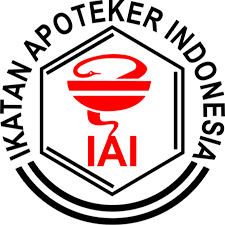Kajian Drug Related Problems (DRPs) Terhadap Pengobatan Pasien Stroke Iskemik di Rumah Sakit Pusat Otak Nasional Jakarta Periode Januari – Desember 2015 S
Okpri Meila(1*), Handika Indri Rochana(2)(1) Fakultas Farmasi Institut Sains dan Teknologi Nasional
(2) Fakultas Farmasi Universitas 17 Agustus 1945 Jakarta
(*) Corresponding Author
Abstract
This study aims to determine the percentage of DRPs of ptients with ischemic stroke at Brain Center National Hospital Jakarta. Based on data from the WHO 2006, each year there are approximately 13 million new stroke patients of which approximatelly 4,4 million of them die within 12 months.When patients undergo a treatment, most patients achieve optimal results that heal diseases suffered by patients but not least the failure in therapy. Therefore, the contribution required to identify, resolve and prevent problems in drug therapy known as Drug Related Problems (DRPs). The method used in this study is cross sectional. Total sample data obtained as many as 360 samples. The results showed indications without drugs of 55.62%, drugs without indication of 15.17%, drug interactions of 10.11%, patients fail to receive the drug of 7.86%, side effects of 6.18% and less drug selection right of 5.06%. Data show that the highest percentage of DRPs are indications without drugs.
Keywords
Full Text:
PDFReferences
Aberg, J.A., Lacy,C.F, Amstrong, L.L, Goldman, M.P, and Lance, L.L., 2009. Drug Information Handbook, 17th edition, Lexi-Comp for the American Pharmacists Association.
Anies.2006. Waspada Ancaman Penyakit Tidak Menular Solusi Pencegahan dari Aspek Perilaku dan Lingkungan.Jakarta: PT Elex Media Komputindo.
BMJ Group. 2008. British National Formulatory (BNF) 56®. London: BMJ Group and the Royal Pharmaceutical Society of Great Britain.
Cipolle, R.J., Strand, L.M., Moorley P.C., 1998,Pharmaceutical care practice, McGraw-Hill Companies.Inc. New York.
Dipiro, Joseph T et al.,2008. Pharmacoterapy, A PathophysiologicApproach, 7thEdition, Mc Graw Hill.
Farizal. 2011. Drug Related Problems (DRPs) PadaPasien Stroke di ICU (Intensive Unit Care)Rumah Sakit Stroke Nasional Bukittinggi.Padang: Program Pasca Sarjana UniversitasAndalas.
Harsono. 2007. Kapita Selekta Neurologi. Edisi ke-2. Yogyakarta: Gadjah Mada University Press, pp:86-88.
Perhimunan Dokter Spesialis Kardiovaskular Indonesia (PERKI). 2013. Pedoman Tatalaksana Dislipidemia. Edisi Kesatu. Jakarta.
Perhimpunan Dokter Spesialis Saraf Indonesia (PERDOSSI). 2011. Guideline Stroke. Jakarta.
Pharmaceutical Care Network Europe. 2010. DRP-Classification (revised 14-01-2010vm)V6.2.http://www.PCNE.org.
Prest MS., Kristanto FC., Tan CK. 2003. Reaksi Obat yang Tidak Dikehendaki, dalam Farmasi Klinis (Clinical Pharmacy), Menuju PengobatanRasional dan Penghargaan Pilihan Pasien.Elex Media Komputindo. Jakarta
Riset Kesehatan Dasar (RISKESDAS) Indonesia.Departemen Kesehatan Republik Indonesia. 2013.
Sirait, et al. 2015.Informasi Spesialite Obat (ISO) Indonesia Volume 49.Jakarta : Isfi Penerbitan. ISSN : 854-4992.
Stockley, H.I,. 2008. Stockley’s Drug Interactions 8th edition. New Zealand: The Pharmaceutical Press.
World Health Organization. 2006. The WHO STEP wise Approach to Stroke Surveillance. Geneva, WHO.
Article Metrics
Abstract view(s): 1117 time(s)PDF: 3674 time(s)
Refbacks
- There are currently no refbacks.








